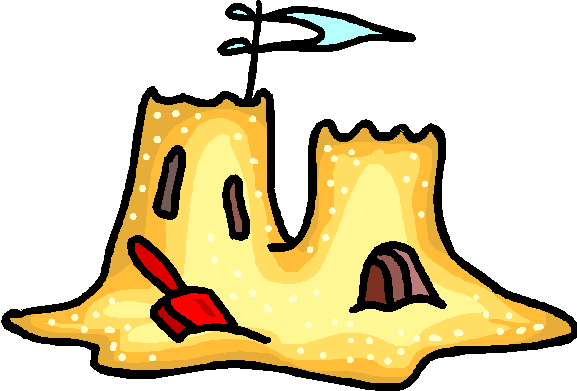
Super Sand Castle

Objectives:
Students are introduced to measurement and nonstandard
units of measurement.
Students measure with
multiple copies of units of the same size, such as paper clips laid end to end.
Materials: Super Sand Castle Saturday by Stuart J. Murphy, "How Do You Measure Up?" activity sheet, assorted classroom objects, sample book, and computer with Internet connection.
Book
Overview:
Three friends compete to see who can
build the tallest sand castle, the deepest moat and the longest wall. They run
into trouble when they start to measure the results, because each contestant
uses a different nonstandard unit of measurement. Sarah's tower is three shovels
tall; Juan's is only two shovels tall, but Sarah's shovel is much smaller than
Juan's Larry gives them sound advice when he points out that, "Spoons and shovels
and people's feet can all be different sizes, but an inch is always in
inch."
Procedure:
The teacher will begin by activating background knowledge about measurement. What do students know about measurement? What do we need measurement for?
Introduce students to story by telling them these children have to measure some things on the beach.
Set a purpose for reading by asking them to listen to the objects they measure with.
Read the story and stop at regular intervals to ask comprehension questions.
After reading, ask students to list what objects were used for measuring. Why was this a problem? What was Larry's advice about measuring with such objects?
Introduce partner activity. Pairs will choose three different items that are handy in class (crayons, markers, book, hands, etc) to measure each other. They will estimate and try measuring each other with each item and record their results on "How Do You Measure Up?" activity sheet.
When all pairs are finished, discuss results and problems with using different objects.
Web Activities: Measurement Book Project: Throughout the unit, students will put together their own book about measurement. They must use the computer to complete their book and it must include art whether drawn through word processing, scanned images, clipart, or use of all of the above. They can do this using any word processing program. In this way, they will practice computer skills such as word processing use, document formatting, finding clip art on the Internet, etc. It can be done in journal format, fiction format, dictionary format, etc. Encourage students to be creative! Refer students to links page. Following links can be especially helpful:
Math Dictionary - definitions and interactive games to illustrate concepts are available at this site.
Math Glossary - definitions with pictures illustrate math concepts.
Have
them be "Internet Scavengers" and fill book with anything and
everything they can find on Measurement. Set specific guidelines for what
things to include or set no boundaries. Let children be imaginative as to
how they compile the information. Show students sample
book.
Assessment:
Completion of "How do You Measure Up?" activity sheet-; evaluated on neatness and
accuracy..
Home Learning: Students will do similar activity at home: Have
them measure three objects in their house with a nonstandard unit such as a
book, toy, hand...
Extension Activity: Write a sequel to Super Sand Castle Saturday. How did the children solve the problem of measuring objects?